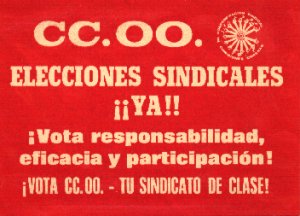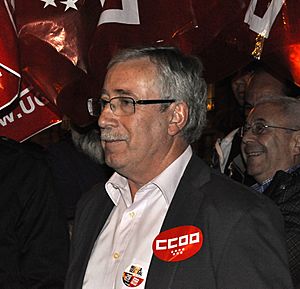Workers' Commissions facts for kids
|
Comisiones Obreras
|
|

Logo
|
|
| Founded | 1976 |
|---|---|
| Headquarters | Madrid, Spain |
| Location |
|
|
Members
|
920,870 (2018) 94,971 union representatives (2018). |
|
Key people
|
Unai Sordo, general secretary |
| Website | www.ccoo.es |
The Workers' Commissions (in Spanish, Comisiones Obreras, often called CCOO) is the largest trade union in Spain. A trade union is a group of workers who join together to protect their rights and interests. Since the 1970s, CCOO has grown to have over 900,000 members. It often wins the most votes in elections where workers choose their representatives. CCOO competes with other big unions like the Unión General de Trabajadores (UGT).
CCOO started in the 1960s. It was formed by groups linked to the Communist Party of Spain and Catholic worker groups. Their main goal was to fight against the government of Francoist Spain and to win better labor rights for workers. Back then, other unions were controlled by the government and didn't truly represent workers. After 1976, all these smaller groups came together to form the single CCOO organization.
Along with other unions, CCOO organized a big general strike in 1976. They also held many protests to improve conditions in Spain. Marcelino Camacho, an important leader in Spanish unions and a member of the Communist Party, was CCOO's first leader from 1976 to 1985. Later, in the early 1990s, CCOO became independent from political parties. Today, it is a union that focuses on talking and making agreements to help workers.
Contents
History of CCOO
How CCOO Started
The first Workers' Commissions began around 1960 in different parts of Spain, like Asturies and Catalonia. They formed when workers started having disagreements with their employers outside of the government-controlled unions. These "commissions" were groups of workers chosen in meetings to represent their colleagues.
The Communist Party of Spain and Christian worker groups helped start these first commissions. Slowly, these temporary groups became more permanent and organized. Many historians believe one of the first places CCOO formed was in the Laciana valley, in a mining company. Another early start was in the La Camocha mine in 1957 during a strike. A big strike by miners in Asturies in 1962 was one of the first large actions by the union against the Francoist government.
Fighting for Rights in Francoist Spain
The union faced harsh treatment in Spain. In 1972, many CCOO leaders were put in jail. This event was known as the Proceso 1001. They stayed in prison for over a year before their trial in December 1973. The leaders were accused of being part of an illegal group and having ties to the Communist Party.
The court gave long prison sentences to the CCOO leaders. For example, Marcelino Camacho was sentenced to 20 years in jail. However, they were all set free in November 1975.
CCOO had a clever plan called entryism. This meant their members secretly joined the government-controlled unions. This plan worked well in the 1975 union elections. CCOO members won most of the positions in the biggest companies in Spain. CCOO led many strikes and worker protests during the last years of Franco's rule and during Spain's move to democracy.
CCOO in a Democratic Spain
After Spain became a democracy, CCOO was officially made legal on April 27, 1977. In 1977, five lawyers who were members of CCOO and the Communist Party were murdered in Madrid. Their funeral was huge, with over 250,000 people attending. The strikes that followed helped the union become legal.
In these years, CCOO grew very quickly. From 1976 to 1978, its membership jumped from 30,000 to over 1.8 million! However, after some national agreements, the number of members went down for a while. It started to grow again after 1987.
CCOO also faced some internal disagreements and groups leaving the union. For example, in 1976, a group linked to another political party left CCOO.
In 1978, CCOO held its first big meeting, called the I Confederal Congress. Marcelino Camacho was re-elected as the leader. CCOO was also the most popular union in the first democratic worker elections in 1978. In 1986, the union took part in big protests against Spain staying in NATO. CCOO asked people to vote "NO" in the NATO vote.
CCOO organized four major general strikes during the government of Felipe González (1985, 1988, 1992, and 1994). These strikes were against the government's economic plans. The 1988 Spanish general strike, organized with the UGT, was especially huge. About 95% of workers took part, which forced the government to change its plans.
From the 1990s to Today
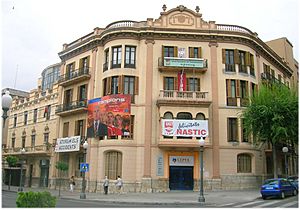
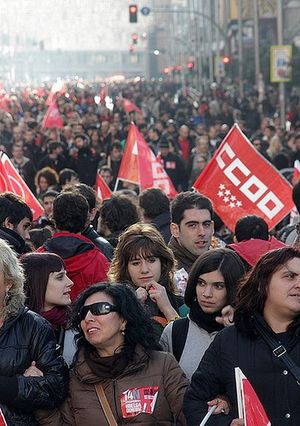
From 1987, Antonio Gutiérrez became the union's general secretary. During his time, CCOO became less connected to the Communist Party of Spain. The union started to focus more on talking and making agreements instead of always striking. Some members, including Marcelino Camacho, disagreed with this change.
In 2002, CCOO and UGT called for another general strike. This was against a government plan that made it easier for companies to fire workers. After big protests, the government mostly withdrew the plan. Around this time, CCOO again reached over one million members. CCOO also spoke out against the Iraq War and joined large protests against it.
In December 2008, CCOO held its Ninth Confederal Congress. At that time, it had 1.2 million members. Ignacio Fernández Toxo was chosen as the new general secretary.
General Secretaries
The General Secretary is the main leader of the CCOO union. They are responsible for guiding the union and representing its members.
Between 1985 and 1997, Antonio Gutiérrez was the General Secretary. After him, José María Fidalgo led the union from 1997 to 2008.
On September 29, 2010, CCOO called a general strike to protest against the government's plans to raise the retirement age and cut spending.
Here is a list of the General Secretaries of CCOO:
| Tenure | Name |
|---|---|
| 1976–1987 | Marcelino Camacho |
| 1987–2000 | Antonio Gutiérrez |
| 2000–2008 | José María Fidalgo |
| 2008–2017 | Ignacio Fernández Toxo |
| 2017–present | Unai Sordo |
How CCOO is Organized
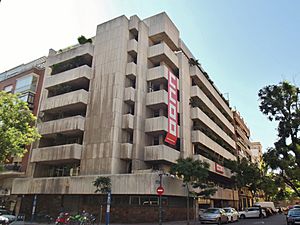
CCOO is organized in different ways. It has offices and groups at local, provincial, and regional levels across Spain. It also has groups for different types of jobs or industries, like a federation for education workers or one for industry workers.
The main decisions for the whole union are made by the Confederal Congress, the Confederal Council, and the Confederal Executive Committee.
Current Branches
CCOO has different branches, called federations, for various types of workers:
| Union | Abbreviation | Founded |
|---|---|---|
| Federation of Citizens' Services | FSC | 2009 |
| Federation of Construction and Services | FCS | 2014 |
| Federation of Education | FE | 1978 |
| Federation of Health and Social Health | FSS | 1977 |
| Federation of Industry | FI | 2014 |
| Federation of Services | Servicios | 2014 |
| Pensioners and Senior Citizens Federation | FPJ | 1978 |
Images for kids
-
Headquarters of CCOO and other unions in Tarragona.
-
General strike on November 14, 2012 in Madrid.
-
CCOO headquarters, Madrid.
See also
 In Spanish: Comisiones Obreras para niños
In Spanish: Comisiones Obreras para niños


